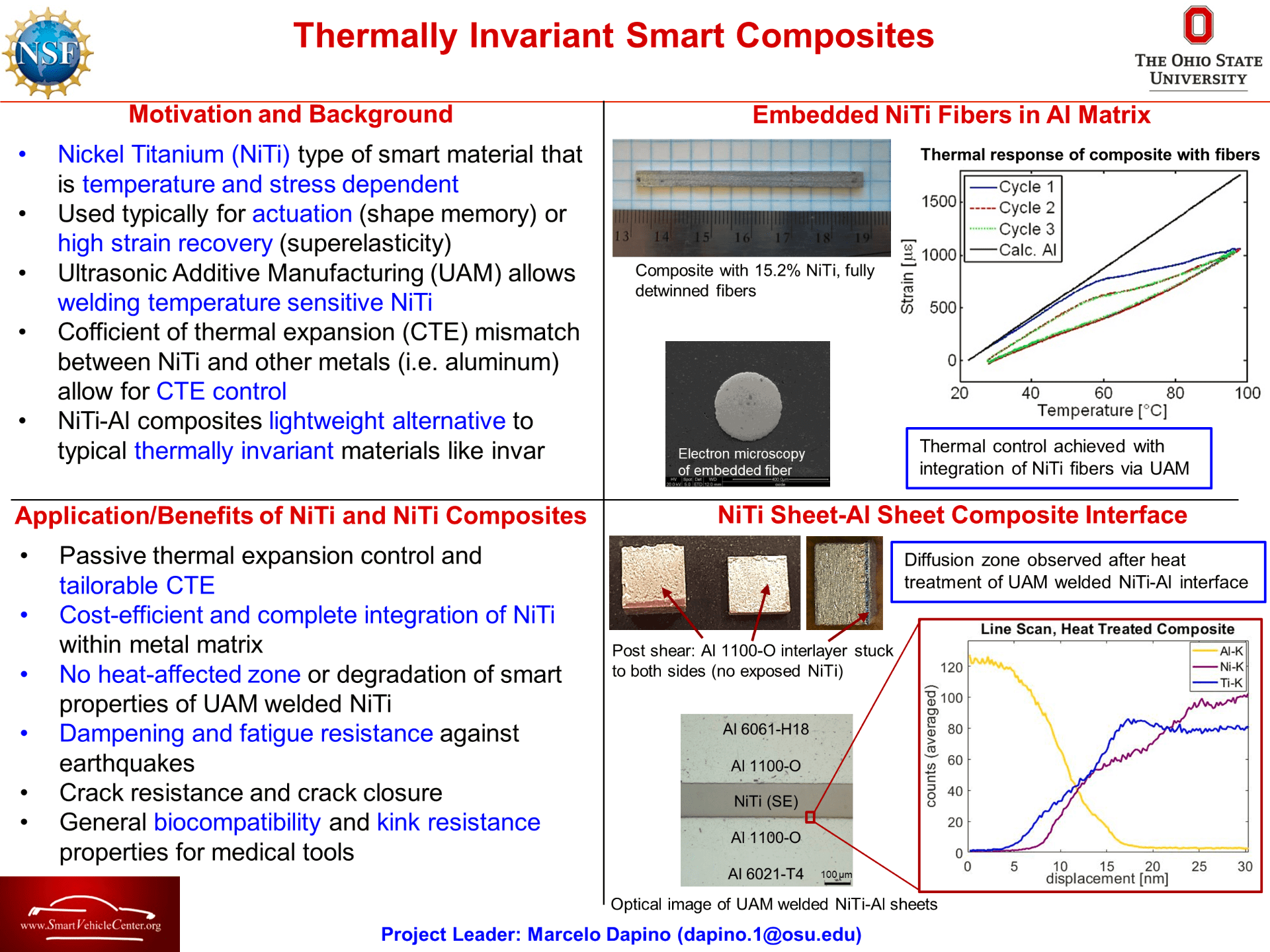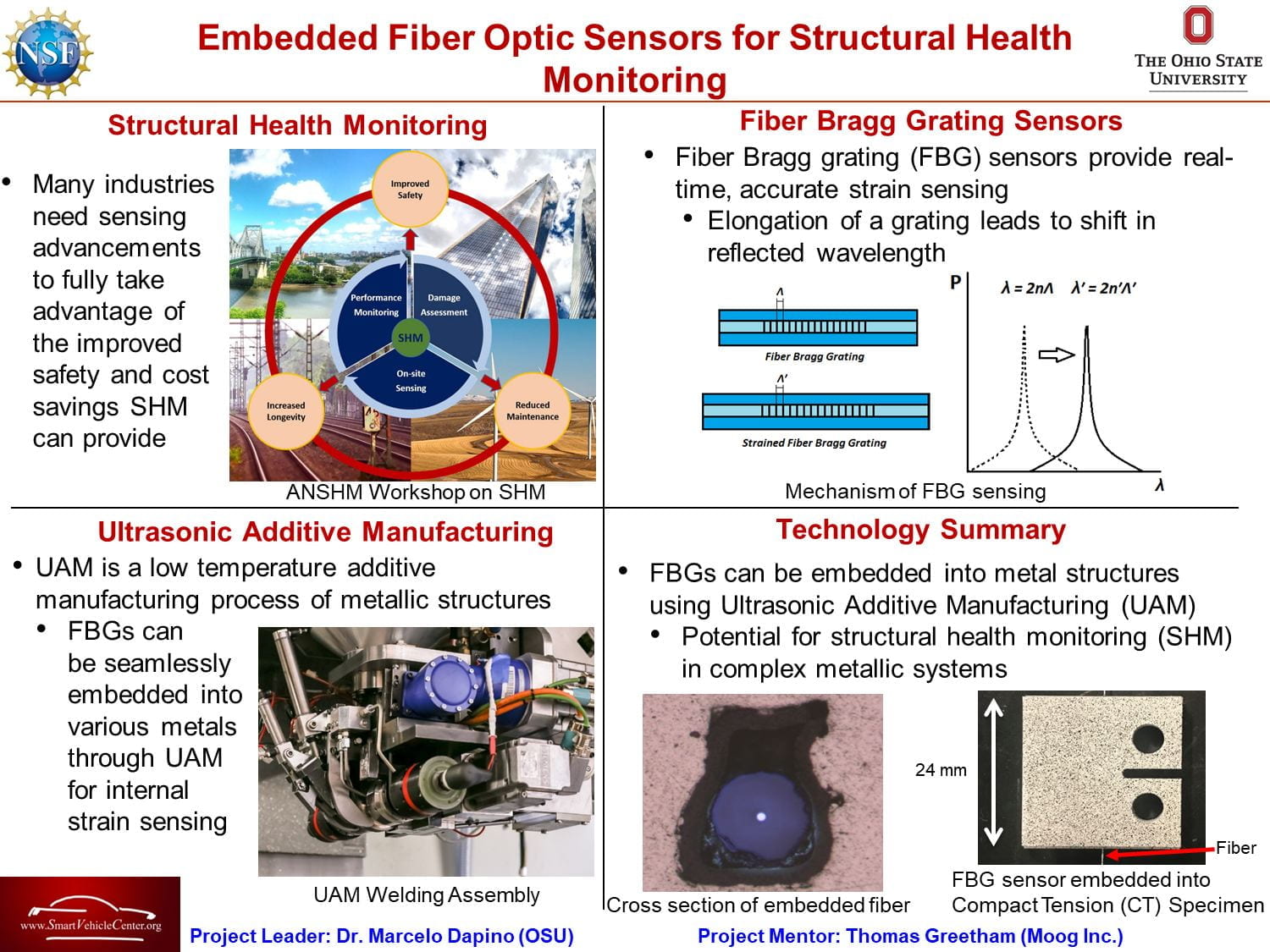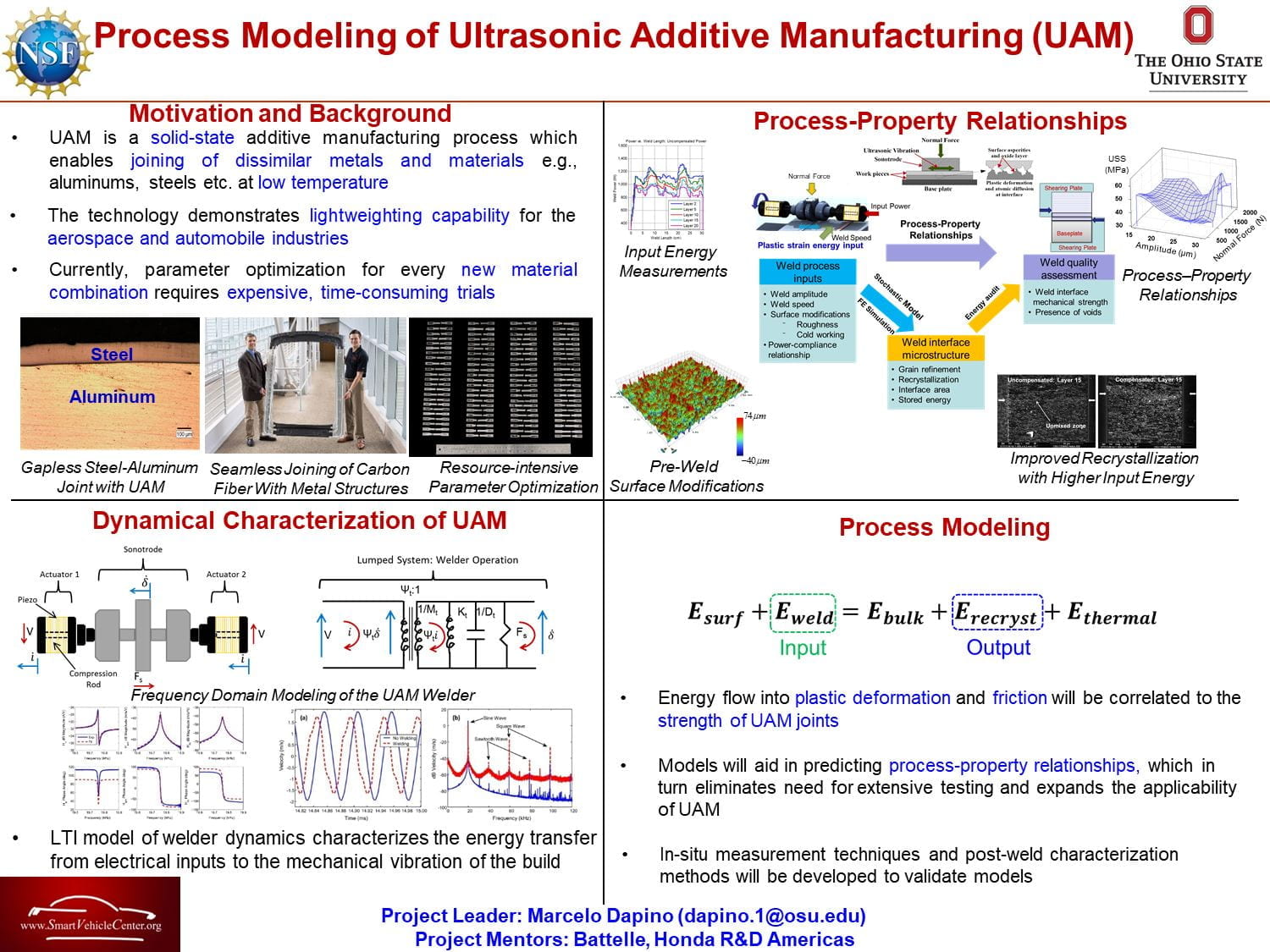 Overview of UAM
Overview of UAM
 Ultrasonic Additive Manufacturing for Automotive Structures
Ultrasonic Additive Manufacturing for Automotive Structures
The demand is rising in industries for lightweighting vehicles and aircraft without compromising strength. Ultrasonic additive manufacturing (UAM) provides an approach to achieve lightweighting without sacrificing mechanical performance through localized reinforcement. This research focuses on high strength fiber and metal reinforcements via UAM. Fibers are embedded into the channel cut in Al matrix and then encapsulated. Metal foils or sheets can be welded onto metal blanks. Sample mechanical properties are evaluated by tensile testing, pullout testing, 3-point bend testing, and axial crush testing.
Relevant Journal Publications:
- Scheidt, Matthew. “Lightweight Aluminum Structures with Embedded Reinforcement Fibers via Ultrasonic Additive Manufacturing.” Masters thesis, The Ohio State University, 2016.
 Ultrasonic Additive Manufacturing of Steels
Ultrasonic Additive Manufacturing of Steels
UAM has been demonstrated to produce robust structures with a variety of material combinations such as Al-Al, Al-Ti, Cu-Cu, Al-Cu, and Al-NiTi. However, due to a lack of fundamental understanding of the UAM process as well as certain equipment limitations, UAM welding of high strength steels has proven challenging. Because of the nature of the process, adequate plastic deformation at the interface is necessary to achieve a metallurgical bond. Compared with relatively soft material such as Al or Cu, it is difficult to weld steel via UAM due to its high strength. Furthermore, undesired top foil surface failure or bottom baseplate-foil cracking can also occur during the welding. This research will focus on developing understanding of the causes of these issues through modeling and experiments, propose strategies and methods to achieve robust UAM steel welding, and conduct corresponding mechanical and microstructural characterization.
Relevant Journal Publications:
- C.-H. Kuo, N. Sridharan, T. HAN, M.J. Dapino, S.S. Babu, “Ultrasonic additive manufacturing of 4130 steel using Ni interlayers,” Science and Technology of Welding and Joining, 24(5), 382390, 2019.
- A. Levy, A. Miriyev, N. Sridharan, T. HAN, E. Tuval, S.S. Babu, M.J. Dapino, and N. Frage, “Ultrasonic additive manufacturing of steel: Method, post-processing treatments and properties,” Journal of Materials Processing Technology. 256, 183-189, 2018.
 Design of Experiments Studies for Mechanical Characterization
Design of Experiments Studies for Mechanical Characterization
Mechanical characterization is crucial to understand the strength of layered samples built using UAM. The design of experiments (DOE) approach is a statistical technique used to efficiently build and test samples to determine optimal process conditions to fabricate UAM composites with the desired strength. The approach developed at OSU determines a design array that governs the parameters of UAM builds, which include the weld force, amplitude, weld speed, temperature. Mechanical testing samples are fabricated and tested in-house using appropriate testing methods such as tensile, shear or push-pin tests. Techniques such as Analysis of variance (ANOVA) and main effects are used to determine which of the parameters investigated have significant influence on the part strength, and at what levels they should be set to maximize mechanical strength.
Relevant Journal Publications:
- P.J. WOLCOTT, C. PAWLOWSKI, L.M. Headings, and M.J. Dapino, “Seam welding of aluminum sheet using ultrasonic additive manufacturing system,” ASME Journal of Manufacturing Science and Engineering, 139(1), 011010, August 2016.
- P. WOLCOTT, A. HEHR, and M.J. Dapino, “Optimized welding parameters for Al 6061 ultrasonic additive manufactured composites,” Journal of Materials Research, Vol. 29, No. 17, 2014.
- C.D. HOPKINS, P.J. WOLCOTT, M.J. Dapino, A.G. Truog, S.S. Babu, and S.A. Fernandez, “Optimizing ultrasonic additive manufactured Al 3003 properties with statistical modeling,” ASME Journal of Engineering Materials and Technology, Vol. 134, Issue 1, 011004, January 2012.
- C.D. HOPKINS, M.J. Dapino, and S.A. Fernandez, “Statistical characterization of Ultrasonic Additive Manufacturing Ti/Al composites,” ASME Journal of Engineering Materials and Technology, Vol. 132, Issue 4, 041006, October 2010.
 Structural Health Monitoring with Fiber Bragg Grating Sensors
Structural Health Monitoring with Fiber Bragg Grating Sensors
Structural health monitoring (SHM) is a rapidly growing field focused on detecting damage in complex systems before catastrophic failure occurs. SHM systems provide the potential to improve safety and significantly reduced costs. Advanced sensor technologies are necessary to fully harness SHM in applications involving harsh or remote environments, life-critical systems, mass production vehicles, robotic systems, and others. Fiber Bragg grating (FBG) sensors are an attractive solution for in-situ health monitoring due to their low weight, resistance to electromagnetic noise, ability to be multiplexed, and accuracy for real-time measurements. Ultrasonic additive manufacturing (UAM) has been demonstrated for solid-state fabrication of 3D structures with embedded FBG sensors. The potential for high temperature applications is also examined through elevated temperature testing. Fiber optics embedded into aluminum using UAM are shown to be more resilient to degradation at elevated temperatures than exposed fibers. UAM embedded FBG sensors are therefore shown to be an effective type of sensor for SHM applications.
Relevant Journal Articles:
- J.J. SCHOMER and M.J. Dapino, “High temperature characterization of fiber Bragg grating sensors embedded into metallic structures through ultrasonic additive manufacturing,” in Proceedings of ASME Conference on Smart Materials, Adaptive Structures and Intelligent Systems, #SMASIS2017-3840, Snowbird, Utah, 18-20 Sept. 2017.
- J.J. SCHOMER, A.J. HEHR, and M.J. Dapino, “Characterization of embedded fiber optic strain sensors into metallic structures via ultrasonic additive manufacturing,” Proceedings of SPIE Smart Structures and Nondestructive Evaluation, #9803-73, Las Vegas, Nevada, 20-24 March 2016.
 Joining of Carbon Fiber Reinforced Polymer and Metal
Joining of Carbon Fiber Reinforced Polymer and Metal
Using the UAM process, carbon fiber and metal can be joined by additively welding metal layers and incorporating channels that allow carbon fiber fabrics to be embedded within a seemingly monolithic aluminum structure. Once the metal transition structure is completed, the carbon fiber fabric layers extending from the UAM structure are cured in a carbon fiber reinforced polymer (CFRP) part to create a composite laminate with a fully integrated metallic welding tab or flange. The composite structure can then be joined to a BIW structure using existing RSW processes and equipment. This approach provides joints with higher strength than SOTA methods (e.g., adhesives, Rivets, and flow drilling screws) due to the hybrid transition structure, where carbon fibers are seamlessly integrated with metals through mechanical interlocking of the carbon fiber in the UAM-welded metal matrix, as well as by epoxy adhesion within the metal matrix. The CFRP would be delivered to the manufacturing line with integrated UAM weld tabs or flanges, thereby eliminating the need for costly changes to factory infrastructure.

Relevant Journal Publications:
- H. Guo, M.B. Gingerich, L.M. Headings, R. Hahnlen, and M.J. Dapino, “Seamless joining of carbon fiber and aluminum using ultrasonic additive manufacturing (UAM),” Composite Structures. Vol. 2018,180-188, 2019
 Thermally Invariant Shape Memory Alloy Composites
Thermally Invariant Shape Memory Alloy Composites
Smart materials, such as Nickel Titanium (NiTi), provide unique mechanical properties without adding complexity to a mechanical system. In the case of NiTi, one ability of this material is to provide actuation due to a temperature change without any further added input. While NiTi can simplify the overall system, the primary difficulty arises from the method of integration of the material into a system. Since NiTi is temperature sensitive, typical integration methods such as laser welding or powder metallurgy use high temperatures that can reduce or eliminate the unique properties of this material. The Ultrasonic Additive Manufacturing (UAM) Lab at OSU utilizes the low temperature process of ultrasonic diffusion welding to embed and join NiTi to other metals as a composite material. These composites are then mechanically and thermally tested in-house and compared to theoretical models in order to accurately tailor the unique effects of the composite.

Relevant Journal Publications:
- X. CHEN, A. HEHR, and M.J. Dapino, and P. Anderson, “Deformation mechanisms in NiTi-Al composites fabricated by ultrasonic additive manufacturing,” Shape Memory and Superelasticity, Volume 1, Issue 3, pp 294-309, 2015.
- A. HEHR and M.J. Dapino, “Interfacial shear strength estimates of NiTi – Al matrix composites fabricated via ultrasonic additive manufacturing,” Composites Part B: Engineering, Vol. 77, 199 – 208, 2015.
- R. HAHNLEN and M.J. Dapino, “NiTi-Al interface strength in Ultrasonic Additive Manufacturing composites,” Composites Part B: Engineering, 59, pp. 101-108, 2014.
 Process Modeling for Ultrasonic Additive Manufacturing
Process Modeling for Ultrasonic Additive Manufacturing
Ultrasonic additive manufacturing (UAM) is an additive manufacturing technology which combines ultrasonic metal welding, CNC machining, and mechanized tape layering to create large gapless near net-shape metallic parts. UAM is currently limited to niche applications, as resource-intensive trials are required to evaluate the feasibility of joining new material combinations and to optimize weld parameters for new geometries due to a lack of process models in the literature with predictive ability to establish process-property relationships. As a result, this research is focused on expanding the applicability of UAM as an additive manufacturing technology by developing tools that will allow the determination of the process parameters for optimal strength of a material combination within a given system parameter envelope. The key thrusts of this research are to develop an energy-based model for process-property relationships of UAM builds, and to characterize the effect of friction and local hardness changes in UAM on bond strength. Analytical and finite element (FE) models will be used to describe the state of stress under plastic deformation in UAM. Nanoindentation technique will be used to characterize local hardness changes in the process. In-situ measurements of the vibration velocity of the components using laser vibrometry will be used to characterize the energy losses associated with friction.
Relevant Journal Publications:
- A. HEHR and M.J. Dapino. “Dynamics of ultrasonic additive manufacturing,” Ultrasonics, 73, 49-66, 2017.
- A. HEHR, P.J. WOLCOTT, and M.J. Dapino, “Effect of weld power and build compliance on ultrasonic consolidation,” Rapid Prototyping Journal, 22 (2), 377-386, 2016.





